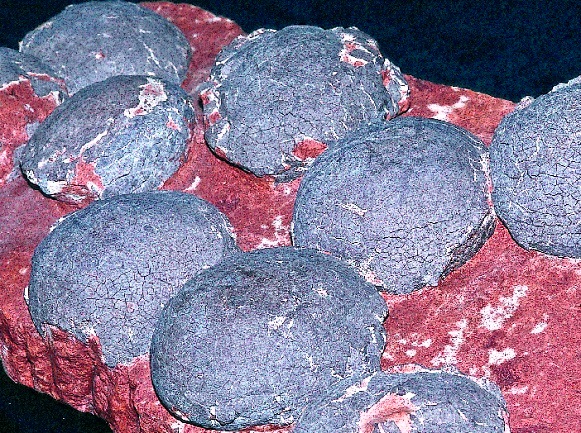Scientists have long thought that dinosaur eggs were white in color and that the evolution of colored eggs in birds was strictly an avian innovation that occurred after the demise of the nonavian dinosaurs. However, technical advancements in the areas of chemical and pigment analyses, particularly as applied to the investigation of fossilized dinosaur eggs, indicate that theropods laid eggs with colorful and often speckled eggshells. With this new information, paleontologists are leaning toward the idea that the evolution of color in the eggshells of birds originated with the theropod dinosaurs prior to the appearance and radiation of avian creatures. See also: Animal evolution; Aves; Dinosauria; Egg (fowl); Evolution of theropod dinosaurs; Fossil; Paleontology

Theropods, which notably include Tyrannosaurus rex and members of the Oviraptor genus, comprised a suborder (Theropoda) of carnivorous bipedal dinosaurs. These nonavian reptiles were the ancestors of present-day avian birds. In the past, some researchers did not realize the deep similarities between theropods and modern birds, and they hesitated to assign comparable traits to both groups. However, ongoing paleontological research is providing evidence of the tight connection between theropods and birds with regard to, for example, the mechanisms and origins of flight, metabolism, and ecological behaviors. In particular, the findings pertaining to colored eggshells furnish further support for the idea that many of the traits of modern birds emerged during the era of the theropods. See also: Avian evolution; Cretaceous bird radiation; Dino-Birds; Physiological ecology (animal); Saurischia
Advanced methods of pigmentation analysis of fossilized eggshells from a number of theropod dinosaurs have revealed the presence of either or both of two important pigments also found in many modern birds. The two pigments are protoporphyrin and biliverdin, which impart red-brown and blue-green colors, respectively, to eggshells. Furthermore, the patterns of pigmentation on the eggshells, including colored spots or speckles, are practically interchangeable between the theropods and modern birds, indicating that egg coloration was likely a one-time evolutionary event that commenced in theropods and continued in birds (as opposed to being a trait that evolved solely within the avian group). Researchers also analyzed the eggshells of nontheropod dinosaurs; in all cases, no color pigments were detected, thereby suggesting that the pigmentation trait was limited to the theropod group. However, scientists still need to seek out the reasons for this initial origin of pigmentation. Camouflage and egg recognition are two probable possibilities, particularly as theropods were the first dinosaurs to lay their eggs in open nests (in contrast to the underground nests of other nontheropod dinosaurs), and egg color would thus be a feature with ecological and evolutionary implications. See also: Animal camouflage; Pigmentation; Protective coloration





